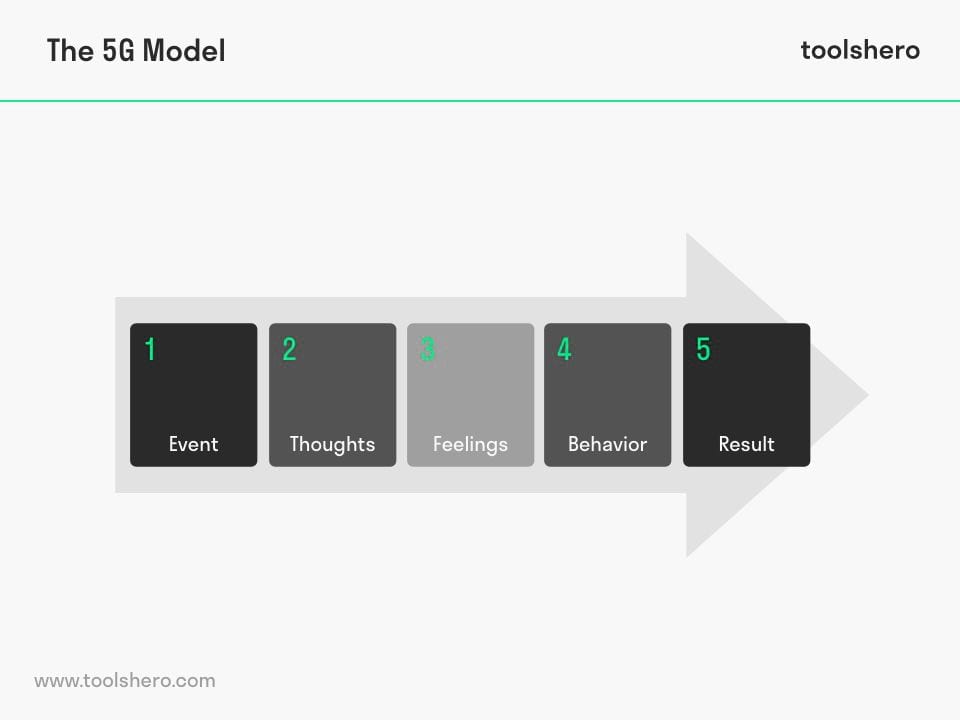5G model explained

5G Model: This article explains the 5G model in a practical way. Next to what it is, this article also higlights why it is important to analyze our own behavior, the five G’s explained and a pratical example. After reading it, you will understand the basics of this self-development and behavior change method. Enjoy reading!
What is the 5G model?
The 5G model is a Cognitive Behavioral Therapy (CBT) tool for organizing thoughts and behavior. It was developed to get a deeper understanding of the effects certain events have on human behavior.
It helps to accurately explain thoughts and emotions and to discover patterns, schemas and non-functional behavior in them. This makes it easier to adjust our behavior and function better.
The meaning of events especially becomes clear from the way we deal with and react to these events. Its interpretation and associated feelings therefore play an important role.
Where one person quickly becomes upset in a certain situation, another can easily park things or ignore them. What goes for everyone is that events can be used to learn something about our own response. That response is also the only thing we can control as humans. The events themselves are outside our influence.
The 5Gs are derived from Dutch and translate as follows:
- Event (Gebeurtenis)
- Thoughts (Gedachten)
- Feelings (Gevoelens)
- Behavior (Gedrag)
- Result (Gevolg)

Figure 1 – the five G’s to analyse behavior
5G model: why is it important to analyze our own behavior?
In difficult times and in difficult situations, people often behave in the same way.
Some people, with the power of positive thinking, will do everything they can to approach the situation in a positive way.
Other people, however, are quick to think negatively and repeat doomsday scenarios in their heads so that the outcome is almost always negative. The focus is on the negative, on what can go wrong.
This focus on the negative keeps people from doing new things. They withdraw from new situations and hardly gain any new experiences. The consequence of this is that in the long term people get stuck in a negative thinking pattern.
This situation will not improve as long as behavior and response remain the same. We call this a non-functional response. This mindset makes people passive and negative.
5G model: the 5Gs explained
The five Gs are briefly explained below:
Event
A person is confronted with events throughout the day. These events are either fun or less fun.
Thoughts
These events lead to having thoughts. These thoughts are not created manually, but automatically enter one’s mind and are actually a concrete interpretation of the events. The kinds of thoughts a person gets when experiencing an event are often based on previous experiences of a similar event.
Feelings
Getting certain thoughts comes with a feeling. The primary, most important categories of feelings are fear, anger, sadness, happiness, etc. These feelings are always personal and based on emotions.
Behaviour
Feeling is expressed in behavior. When someone is afraid of something, this person often chooses the easy way out. This also happens when someone knows that choosing the easy way out does not lead to the desired result. Behavior stems from feelings and emotions and is therefore not always rational.
Result
The behavior that one shows has consequences. There are fun and less fun results associated with different types of behavior.
How can the 5G model help?
The 5G model can help to map these behaviors and the patterns in these behaviours. Write down what thoughts and feelings come up as you experience an event. Afterwards, determine whether these feelings and thoughts were realistic or not.
Then determine whether the thoughts and feelings you have are helping you get to the desired result. Or are these based on fear of the unknown or simply an irrational fear of something that need not be feared? What would happen when negative thoughts are replaced by positive thoughts? How would this affect your feelings and behavior? Would the desired outcome be achieved?
Practical example
In the example below you can read how one event could turn out in two different ways.
Situation 1
- Event: Ricky has vowed to abstain from alcohol for a month. When having lunch with his 5 friends, a bottle of wine is ordered. His friends ask him to join in the fun.
- Thoughts: If I say no, everyone thinks I’m unsociable and boring.
- Feeling: Fear of the opinion of his friends. Possibly a need for approval and prone to peer pressure.
- Behavior: Even though Ricky had resolved not to drink alcohol, he still says yes to the glass of wine that is offered to him.
- Result: Ricky does not keep his own agreement and therefore does not achieve the desired outcome.
Situation 2
- Event: Ricky has vowed to abstain from alcohol for a month. When having lunch with his 5 friends, a bottle of wine is ordered. His friends ask him to join in the fun.
- Thoughts: I’d like to have a glass of wine, but I can safely explain to my friends why I don’t want to drink right now and ask for support to help me with this.
- Feeling: Proud of keeping himself to his own agreement.
- Behavior: Ricky shares his intentions with his friend and does not drink wine.
- Result: Ricky sticks to his own agreements and achieves his goal.
Behavioral Therapy
As mentioned, the 5G model is based on Cogntive Behavioral Therapy, or CBT and on the Aaron Beck model. This Cognitive Behavioral Therapy focuses in particular on changing and eliminating useless and harmful thoughts. By changing harmful thinking patterns, you can find relief from intense emotions such as anxiety that can lead to depression.
CBT methods ensure that the brain is re-learned how to deal with certain thoughts. This often changes the client’s mood in the short and long term. This form of therapy has been shown to be effective in:
- Anxiety disorders
- Preventing and fighting depression
- Treatment of post-traumatic stress disorder (PTSD)
- Chronic forms of pain
- Hormonal problems
- Stress
- Self-image problems
- Panic attacks
5G model: why negative thoughts?
Even if one doesn’t need cognitive behavioral therapy, it can still be a good idea to use it every now and then. Many people experience stress on a daily basis. With this method, this stress can be coped with.
Many people see negative thoughts that arise during stress as an inner bully. These thoughts come from a certain part of the brain. This part of the brain is widely associated with a mechanism that wants to help us. Thoughts often miss the purpose and so more often make us feel worse than better. This dysfunction can be solved with CBT.
In summary, you can take the following steps to get started:
- Identify a negative thought that often crosses your mind.
- Ask yourself what the purpose is of these thoughts.
- Gather evidence to disprove these thoughts.
- Ask yourself what the wisest and most calm version of yourself would say about these thoughts.
- Make sure you can focus this criticism on something else. Extract meaning from the thoughts.
- Think of another thought for yourself that can help you get out of a negative situation.
- Remind yourself of the new thought until you believe it.
Now it’s your turn
What do you think? Do you recognize the explanation about the 5G model? Can you use this model to organize your thoughts and actions? What other methods for mapping behavior do you know? Do you have any tips or comments?
Share your experience and knowledge in the comments box below.
More information
- van den Berg, B. (unknown). Gedachtentraining… maar dan anders.
- Rothbaum, B. O., Meadows, E. A., Resick, P., & Foy, D. W. (2000). Cognitive-behavioral therapy.
- Beck, A. T., Ward, C., Mendelson, M., Mock, J., & Erbaugh, J. J. A. G. P. (1961). Beck depression inventory (BDI). Arch Gen Psychiatry, 4(6), 561-571.
- Hollon, S. D., & Beck, A. T. (2013). Cognitive and cognitive-behavioral therapies. Bergin and Garfield’s handbook of psychotherapy and behavior change, 6, 393-442.
How to cite this article:
Janse, B. (2022). 5G model. Retrieved [insert date] from Toolshero: https://www.toolshero.com/psychology/5g-model/
Published on: 08/10/2022 | Last update: 04/17/2023
Add a link to this page on your website:
<a href=”https://www.toolshero.com/psychology/5g-model/”>Toolshero: 5G model</a>












